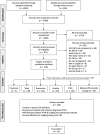Neuroimaging Correlates of Post-Traumatic Stress Disorder in Traumatic Brain Injury: A Systematic Review of the Literature
- PMID: 36259461
- PMCID: PMC10402701
- DOI: 10.1089/neu.2021.0453
Neuroimaging Correlates of Post-Traumatic Stress Disorder in Traumatic Brain Injury: A Systematic Review of the Literature
Abstract
Neuroimaging is widely utilized in studying traumatic brain injury (TBI) and post-traumatic stress disorder (PTSD). The risk for PTSD is greater after TBI than after non-TBI trauma, and PTSD is associated with worse outcomes after TBI. Studying the neuroimaging correlates of TBI-related PTSD may provide insights into the etiology of both conditions and help identify those TBI patients most at risk of developing persistent symptoms. The objectives of this systematic review were to examine the current literature on neuroimaging in TBI-related PTSD, summarize key findings, and highlight strengths and limitations to guide future research. A Preferred Reporting Items for Systematic Review and Meta-Analysis Protocols (PRISMA) compliant literature search was conducted in PubMed (MEDLINE®), PsycINFO, Embase, and Scopus databases prior to January 2022. The database query yielded 4486 articles, which were narrowed based on specified inclusion criteria to a final cohort of 16 studies, composed of 854 participants with TBI. There was no consensus regarding neuroimaging correlates of TBI-related PTSD among the included articles. A small number of studies suggest that TBI-related PTSD is associated with white matter tract changes, particularly in frontotemporal regions, as well as changes in whole-brain networks of resting-state connectivity. Future studies hoping to identify reliable neuroimaging correlates of TBI-related PTSD would benefit from ensuring consistent case definition, preferably with clinician-diagnosed TBI and PTSD, selection of comparable control groups, and attention to imaging timing post-injury. Prospective studies are needed and should aim to further differentiate predisposing factors from sequelae of TBI-related PTSD.
Keywords: neuroimaging; neuropsychiatric symptoms; post-traumatic stress disorder; traumatic brain injury.
Conflict of interest statement
No competing financial interests exist.
Figures




Similar articles
-
Pre-deployment programmes for building resilience in military and frontline emergency service personnel.Cochrane Database Syst Rev. 2021 Dec 6;12(12):CD013242. doi: 10.1002/14651858.CD013242.pub2. Cochrane Database Syst Rev. 2021. PMID: 34870330 Free PMC article.
-
Neuroimaging Correlates of Syndromal Anxiety Following Traumatic Brain Injury: A Systematic Review of the Literature.J Acad Consult Liaison Psychiatry. 2022 Mar-Apr;63(2):119-132. doi: 10.1016/j.jaclp.2021.09.001. Epub 2021 Sep 14. J Acad Consult Liaison Psychiatry. 2022. PMID: 34534701
-
The association between post-traumatic stress disorder (PTSD) and cognitive impairment: A systematic review of neuroimaging findings.J Psychiatr Res. 2023 Aug;164:259-269. doi: 10.1016/j.jpsychires.2023.06.016. Epub 2023 Jun 16. J Psychiatr Res. 2023. PMID: 37390621
-
Home treatment for mental health problems: a systematic review.Health Technol Assess. 2001;5(15):1-139. doi: 10.3310/hta5150. Health Technol Assess. 2001. PMID: 11532236
-
Behavioral and Emotional Dyscontrol Following Traumatic Brain Injury: A Systematic Review of Neuroimaging and Electrophysiological Correlates.J Acad Consult Liaison Psychiatry. 2022 Nov-Dec;63(6):579-598. doi: 10.1016/j.jaclp.2022.05.004. Epub 2022 May 23. J Acad Consult Liaison Psychiatry. 2022. PMID: 35618223 Free PMC article.
Cited by
-
From Acute Injury to Chronic Neurodegeneration: Molecular Mechanisms Linking Secondary Brain Injury to Long-Term Pathology.Int J Mol Sci. 2025 Jul 25;26(15):7191. doi: 10.3390/ijms26157191. Int J Mol Sci. 2025. PMID: 40806328 Free PMC article. Review.
-
Genetic and peripheral biomarkers of comorbid posttraumatic stress disorder and traumatic brain injury: a systematic review.Front Neurol. 2025 Jan 27;16:1500667. doi: 10.3389/fneur.2025.1500667. eCollection 2025. Front Neurol. 2025. PMID: 39931547 Free PMC article.
-
ENIGMA's simple seven: Recommendations to enhance the reproducibility of resting-state fMRI in traumatic brain injury.Neuroimage Clin. 2024;42:103585. doi: 10.1016/j.nicl.2024.103585. Epub 2024 Mar 5. Neuroimage Clin. 2024. PMID: 38531165 Free PMC article. Review.
-
COVID-19 Pandemic Impacts on STRESS, PTSD, and Prefrontal Cortical Thickness in Pre-Pandemic Trauma Survivors.J Pers Med. 2025 Mar 26;15(4):127. doi: 10.3390/jpm15040127. J Pers Med. 2025. PMID: 40278306 Free PMC article.
-
The Relationship between Post-Traumatic Stress Disorder Due to Brain Injury and Glutamate Intake: A Systematic Review.Nutrients. 2024 Mar 21;16(6):901. doi: 10.3390/nu16060901. Nutrients. 2024. PMID: 38542812 Free PMC article.
References
-
- Cole WR, Bailie JM. Neurocognitive and Psychiatric Symptoms Following Mild Traumatic Brain Injury. Transl Res Trauma Brain Inj 2016;379–394. - PubMed
Publication types
MeSH terms
Grants and funding
LinkOut - more resources
Full Text Sources
Medical

